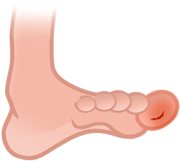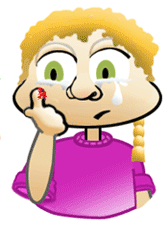The story of minor wounds and how to cure them is extremely interesting. 😉 You’ve most probably cut yourself, been grazed or fallen and hurt your knee or had a sharp object driven into your foot at some point…
When you did this, I’ll bet someone told you to put some oxygenated water on it to cure it, and you didn’t like it because it STUNG!!!!!
Well, the fact that it stung meant that your body was reacting.
What is a wound?
 |
Wounds are the result of an attack made on the skin. The skin gives us great protection, but when it is exposed to a blow from a stone, a cut from a pair of scissors or a knife, a wound made by a sharp point or a piece of metal… it becomes damaged. Luckily, it grows again. |
 |
But there is much more to skin than you think. When we look at our bodies, we ONLY see part of the skin, the outer layer, what doctors call the epidermis. Below the epidermis, in the area underneath the skin, which is called the dermis, there are a great many layers and cells that could become infected. |
 |
And infection is bad for the health. That’s why wounds must be cured properly.
No matter whether it stings just a little or a lot. Imagine, if you can, that the skin is like an omelette cake and that we can only see the omelette that is on the top. |
Types of wounds
What about being bitten? Have you ever been bitten by a dog?
A bite is an important wound, so we’ll tell you more about it later.
 |
Before we do, you need to know how many types of skin wounds there are:
|
The most common wounds (and also the least serious) are erosions, which consist of scrapes on the surface of the skin that leave small blood vessels visible, in which the blood is stored. That is why when we are wounded, we sometimes see BLOOD!!!
This type of wound is popularly know as grazes or scrapes, and are caused by falls, being tripped, falling off one’s bike.
They usually occur on the knees, elbows, brow…
In an erosion, tiny fragments of the material against which the person has collided may be present: grains of sand, asphalt or other materials.
ALL TRACES OF SAND OR DIRT MUST BE REMOVED FROM THE WOUND PRIOR TO CURING IT, TO PREVENT INFECTION!!
 |
Wounds caused by a cut are known as incisive wounds: a cut is a separation of the edges of the skin. This type of wound is usually caused by a knife, a piece of broken glass or the edge of a tin can. These wounds usually bleed because the object that penetrates the skin opens up the blood vessels that are there.
One of the problems that may arise with these wounds is that as they are deeper, they may affect other parts of the body, such as tendons, muscles or nerves. |
| Penetrating wounds are also important wounds. These are caused by sharp objects and are difficult to see. It is hard to see whether they are straight or curved, if they are very deep or not too deep… and the blood flows from them without stopping.
The most serious of these are those produced near the heart, in the chest or the stomach, as they may affect the intestines or the liver… Contusive wounds have irregular edges and the skin is greatly damaged. Sometimes, the wounds are caused by a little of all the above, for which reason they are known as incisive-contusive wounds; they are caused by a little of each. |
 |
What dangers may a wound present?
The danger common to all wounds is INFECTION!!!!

When the skin is opened up, the micro organisms producing infections can easily penetrate it, and enter our bodies.
It sometimes happens that the object causing the wound is dirty and the germs enter our body.
If the wound is cured properly, there will be no problem, but one must always check to ensure that there is no PUS!!!
Pus is a sign of infection. Like a visiting card. Here I am, ready to infect everything!
The greatest danger in a wound is becoming infected with TETANUS!!!
Tetanus is an infectious illness caused by the bacteria Clostridium tetani. This is its Latin name, and doctors refer to it by this name. People usually refer to it as tetanus.
The best way to avoid becoming infected by this illness is to be vaccinated against it.
If you have been vaccinated based on the vaccination programme, you are protected against it. Remember that to ensure you are protected against it for the rest of your life, you will have to be re-vaccinated every 10 years.
How to cure a wound?
You have probably had a wound cured at sometime in your life…
Do you remember falling off the swing? Or when you fell down when you were skating?
Perhaps it hurt quite a bit, but that was because to cure the wound, it had to be cleaned and disinfected.
We could say that TO CURE A WOUND, YOU MUST DO AS FOLLOWS:
 |
1. Remain calm. Everyone must be calm, both the wounded person and the person who is going to cure the wound. |
 |
2. Wash your hands thoroughly with soap and water. |
 |
3. Remove the clothing or whatever covers the wound. |
 |
4. Clean the wound with a spurt of cold water. |
 |
5. After washing the wound, use a piece of gauze to remove any dirt or traces of “things” that may be inside the wound.
DON’t use cotton wool, as it may leave filaments… If you have oxygenated water available, pour some onto the wound, EVEN THOUGH IT STINGS!!! |
 |
6. Rinse the wound. |
 |
7.Apply an antiseptic to disinfect it (preferably one that contains iodine), using a piece of sterile gauze. |
 |
8. Put a sticking plaster over the wound to protect it. Or a piece of gauze adhered with sticking plaster. |
 |
9. Tell a grown-up what you have done at once; a teacher, your mother, father, the babysitter… |
 |
10. Well, that’s that. Wash your hands and think about whether you would like to be a doctor when you grow up! |
What do you need to know?
|
|
|
